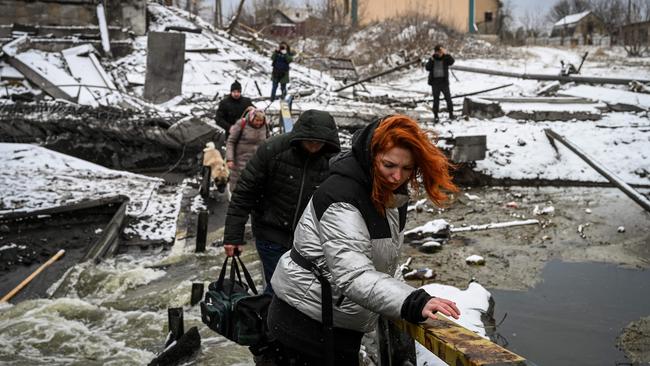Russia targest civilian areas in shift to demoralise resistance
Russian forces, frustrated in plans for a quick victory, shifted to a new strategy to reignite its slowing military advance.

Russian forces, frustrated in their plan for a quick victory, are switching to a new strategy of deliberately targeting civilian areas in an attempt to demoralise the fierce Ukrainian resistance and reignite their slowing military advance.
On Wednesday (Australian time), Russia’s Defence Ministry said it would strike Ukrainian intelligence and communications facilities in central Kyiv that it claimed were being used for “information attacks” against Russia, and urged residents living nearby to leave for their own safety.
Western diplomats took the warning as a signal that a massive strike on Kyiv’s residential areas was imminent. Some of the remaining staff at foreign embassies left Ukraine’s capital.
Live-cam footage from Kharkiv’s central Freedom Square showed a missile landing just outside the local government’s headquarters, with a fireball charring nearby buildings and cars.
Ukraine’s national emergency service reported that seven people were killed and 24 injured in the strike. Later in the day, additional Russian airstrikes hit Kharkiv’s residential neighbourhoods, killing more than 10 civilians, local authorities said.
“A missile targeting the central square of a city is open, undisguised terrorism,” said Ukrainian President Volodymyr Zelensky, adding that numerous children had died in other attacks.
“It’s terrorism that aims to break us, to break our resistance.”
The strike came in the midst of signs that Russia’s military forces were pausing their advance on Kyiv, having encountered a range of obstacles since entering Ukraine. A senior US defence official said the Russian advance had stalled due to food and fuel shortages, Ukrainian resistance, and the slower-than-expected troop movement. The Russians “are regrouping and trying to adjust to the challenges”, the official said.
An airstrike on the capital’s iTV tower killed five people who were nearby and injured another five. It also temporarily disabled the broadcasting ability of Ukraine’s central TV channels. The TV tower stands in the Babi Yar Holocaust memorial. More than 30,000 Jews were slaughtered by the Nazis during World War II in the Babi Yar ravine
Kharkiv, Ukraine’s second-largest city, whose population is mostly Russian-speaking, has put up stiff resistance to Russian advances since President Vladimir Putin began the invasion on Thursday.
Ukrainian forces repelled a tank column heading to Kharkiv last week and then killed or captured a unit of Russian troops that entered the city over the weekend.
On Monday, Russian forces unleashed a barrage of rocket fire against residential neighbourhoods in Kharkiv, killing at least 10 civilians, including three children and their parents who were incinerated in a car struck by a Russian projectile, and injuring at least 40, according to officials.
Some 87 Kharkiv apartment buildings have been damaged, and several parts of Kharkiv no longer have water, electricity or heating, Mayor Ihor Terekhov told Ukrainian TV channels. Kharkiv, which served as the capital of Ukraine in the 1920s and 1930s, is home to some 1.4 million people.
“This is not a random mistaken salvo, but a conscious extermination of people. The Russians knew what they were firing at,” Mr Zelensky said.
In the eastern Sumy region, regional governor Dmytro Zhyvytski said that a salvo from Russian multiple-rocket launchers in the town of Akhtyrka killed as many as 70 Ukrainian soldiers.
In the large southern city of Mariupol, which advancing Russian forces have nearly encircled, most neighbourhoods were without power or heating after persistent Russian shelling hit electricity substations, according to local authorities.
The Wall Street Journal



To join the conversation, please log in. Don't have an account? Register
Join the conversation, you are commenting as Logout